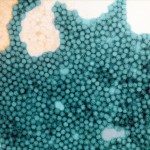Lien vers Pubmed [PMID] – 11763332
Dev Biol (Basel) 2001;105:225-30
Many survivors of poliomyelitis, several decades after the acute phase of the disease, develop a set of new muscle symptoms called post-polio syndrome. The persistence of poliovirus (PV) in the central nervous system (CNS) may be involved in the aetiology of this syndrome. By using a mouse model, we have shown that PV persists in the CNS of paralysed mice for over a year after the acute disease. Detection of PV plus- and minus-strand RNAs in the spinal cord of paralysed mice suggested continuous PV RNA replication in the CNS. However, infectious PV particles could not be recovered from homogenates of CNS from paralysed mice beyond 20 days post-paralysis, indicating that PV replication was restricted. In an attempt to identify the molecular mechanism by which PV replication was limited, PV plus- and minus-strand RNA levels were estimated in the CNS of persistently infected mice by a semi-quantitative RT-nested PCR method. Results revealed that RNA replication was inhibited at the level of plus-strand RNA synthesis during persistent infection. Similar results were obtained in neuroblastoma IMR-32 cell cultures persistently infected with PV Restriction of PV RNA synthesis could be involved in persistence by limiting PV replication.
